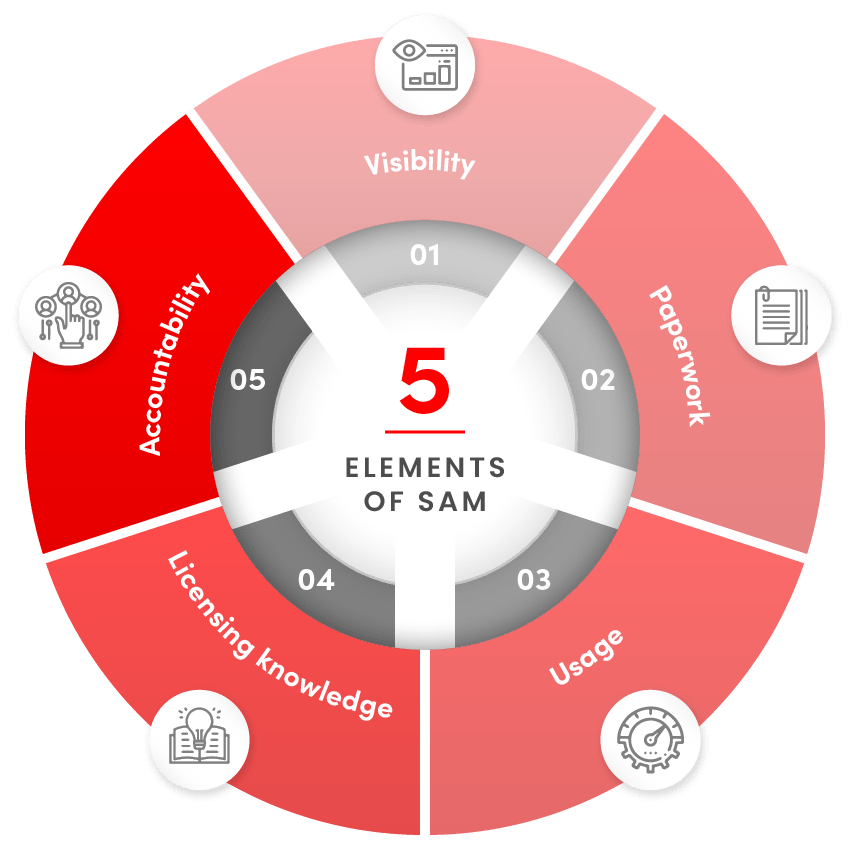Software Asset Management: the five elements for health

Inoapps Oracle Licensing Series: Part Four
By Hazel Hopes
Licensing Consultant at Inoapps
In my February blog, I talked about the importance of understanding your Software as a Service (SaaS) deployments to ensure you’re utilizing your subscriptions correctly. This month, I’ll be discussing the key elements of Software Asset Management.
Software Asset Management, commonly known in our industry as SAM, is a broad scope of processes, tasks and knowledge that helps you manage your software assets. Those assets are often the backbone of your business, but it’s all too easy to lose track of what you have and how it’s being used.
This can be expensive in several ways, but here are two key points to consider. Firstly, you may not be using your licenses or subscriptions in an optimum way, thus wasting money. Secondly, if you’re using any of your software without a license or subscription, it can work out to be expensive in penalties if your vendor then decides to audit you.
Let’s look at some of the areas you need to consider to take control of your software estate. Fundamentally, there are lots of moving parts across your whole business. So where to start?
Here are my top five suggestions:

1. Visibility
You can’t manage what you can’t find or don’t know about.
Here’s what you need to know (and document):
- What products you have
- Where the products are
- How many products there are
- How crucial the product is to your business
The last point shouldn’t be overlooked. If you find yourself in the unfortunate position of needing to reduce usage to match purchases, knowing what’s critical and what could be dispensable is vital.
Read about the different methods you can use to find out which products you have.
2. Paperwork
Once you’ve found and documented your actual usage, you then have to know what you bought in the first place.
Here’s what you’re looking for:
- Original agreements
- Order documents
- Support renewals
Find out about the different types of documentation you can use here.
3. Usage
You’ve now documented your deployment and matched it to your paperwork. Next comes the question of configuration and usage.
This falls broadly into two categories:
- Do you have rights to use the products?
- Are you using them correctly?
This relates to how your agreements allow you to use a product. For example, some entities in your organization may be excluded. Or some territories or third parties. Plus, are you using products in the way the license you’ve bought says you should? It’s not uncommon for vendors to wrap product usage up in very specific policy restrictions and complex dos and don’ts.
This leads us neatly to…
4. Licensing Knowledge
It takes time and effort to know all you can about software licensing. I’ve been in the business ten years and I still come across new conundrums from time to time. With Oracle, for example, you have a product stack that isn’t static and the on-premises data center world is very different to the instant access cloud environment. Different rules apply that result in different issues.
Unless you have a lot of time and expertise on your hands, I’d urge you to engage with a knowledgeable Oracle partner who gives you confidence and shares knowledge so you can learn too.
5. Accountability
Once you’ve found the product, understood it, compared it to your agreements, purchases and support, what happens if there are things to fix?
This is where accountability comes in. Someone, somewhere must be accountable for ensuring compliance is met through documented activities and ongoing processes. This individual or group forms the framework of your SAM team and will drive ongoing compliance efficiency into the future.
Accountability is a big subject. Find out about the people and processes involved.
How Inoapps can help
From infrastructure to applications, procurement to decommissioning, Inoapps has extensive experience of Oracle software asset management. We were the first partner globally to be approved for the Oracle SAM Program, which means we are vetted and trusted by Oracle to assess your on-premises estate and help you ensure your licenses match your utilization. All in preparation for an audit waiver request, made possible by the program. Download our Oracle SAM Program datasheet to find out more.
We also provide a SaaS Subscription Service to help our customers stay on top of their Oracle Cloud deployments, and our Oracle License Optimization service is designed to ensure you maximize your Oracle investment. Find out more on our Licensing & Subscription Services web page.
This blog tells you about what you need to consider as part of your SAM program. In our next blog, I take a deeper dive into some of the concepts I've discussed here.
